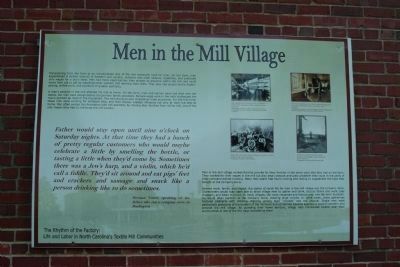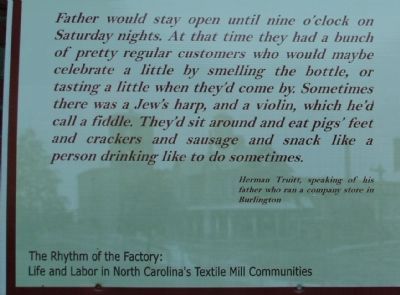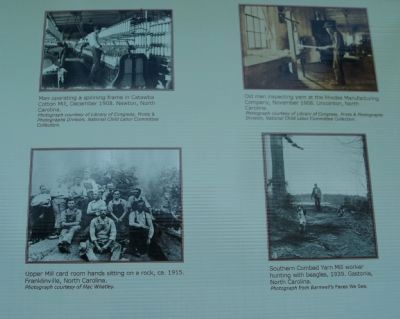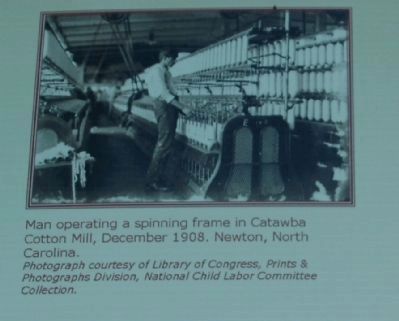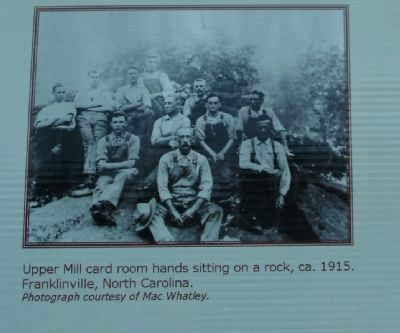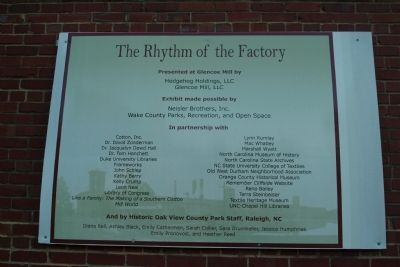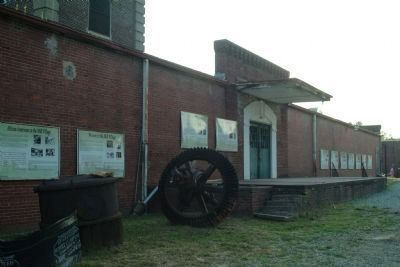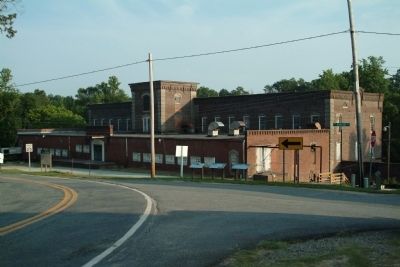Glencoe Village near Burlington in Alamance County, North Carolina — The American South (South Atlantic)
Men in the Mill Village
A man’s position in the mill affected his role at home. On the farm, men and women each had their own set duties, but men were recognized as the primary family providers. Female wage work in the mills challenged the man’s position as head of the household. The mill structure also threatened male autonomy. For the first time, these men were working for someone else, and their bosses wielded influence not only at work but also at home. Men often vented frustration with mill authority by moving their families from mill to mill, one of the only means they had to challenge the mill owners.
Father would stay open until nine o’clock on Saturday nights. At that time they had a bunch of pretty regular customers who would maybe celebrate a little by smelling the bottle, or tasting a little when they’d come by. Sometimes there was a Jew’s harp, and a violin, which he’d call a fiddle. They’d sit around and eat pigs’ feet and crackers and sausage and snack like a person drinking like to do sometimes. Herman Truitt, speaking of his father who ran a company store in Burlington.
Men in the mill village worked hard to provide for their families in the same ways that they had on the farm. They worked for their wages in the mill but also kept livestock and grew whatever they could in the yards of their company-owned housing. Many men spent free hours hunting and fishing to supplement the food they bought at the company store.
Beyond work, family, and church, the center of social life for men in the mill village was the company store. Storeowners would stay open late to allow village men to gather and drink, discuss family and work, play checkers, and listen to music. In many villages, the most respected and famous man was the town musician. He would often perform at the company store, drawing large crowds. In some cases, these gatherings fostered problems with drinking. Fighting among town “rowdies” was not unusual. Single men were particularly protective of the borders of the mill town and sometimes became aggressive toward outsiders who entered the mill village. By guarding their home territory, village men maintained control over their communities in one of the few ways available to them.
Topics. This historical marker is listed in these topic lists: Industry & Commerce • Settlements & Settlers.
Location. 36° 8.339′ N, 79° 25.678′ W. Marker is near Burlington, North Carolina, in Alamance County. It is in Glencoe Village. Marker is on Glencoe Street, on the left when traveling west. Glencoe Village is 3 miles north of Burlington, NC from NC Highway 62. Touch for map. Marker is at or near this postal address: 2406 Glencoe St, Burlington NC 27217, United States of America. Touch for directions.
Other nearby markers. At least 8 other markers are within walking distance of this marker. Picker House and Dye House (here, next to this marker); The Mill Buildings (here, next to this marker); Women in the Mill Village (here, next to this marker); After the Whistle Blows (here, next to this marker); Children in the Mill Village (here, next to this marker); Living in a Mill-Centered World (here, next to this marker); Neighbors Divided (here, next to this marker); Calling the Mill Village 'Home' (here, next to this marker). Touch for a list and map of all markers in Burlington.
Related markers. Click here for a list of markers that are related to this marker. To better understand the relationship, study each marker in the order shown.
Additional keywords. Alamance, Glencoe Cotton Mill, Burlington, Company Shops, textiles, fabrics
Credits. This page was last revised on May 11, 2023. It was originally submitted on July 7, 2010, by Patrick G. Jordan of Graham, North Carolina. This page has been viewed 722 times since then and 9 times this year. Last updated on May 9, 2023, by Michael Buckner of Durham, North Carolina. Photos: 1, 2, 3. submitted on July 7, 2010, by Patrick G. Jordan of Graham, North Carolina. 4. submitted on July 11, 2010, by Patrick G. Jordan of Graham, North Carolina. 5, 6, 7, 8. submitted on July 7, 2010, by Patrick G. Jordan of Graham, North Carolina. • J. Makali Bruton was the editor who published this page.
